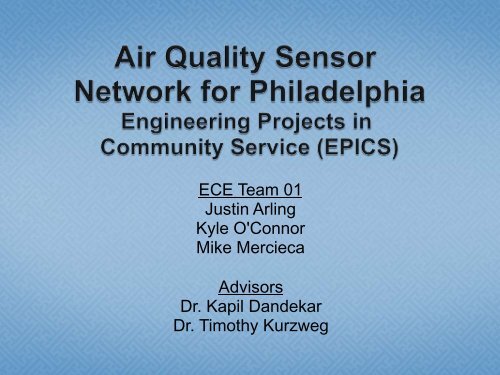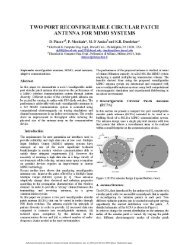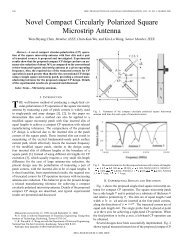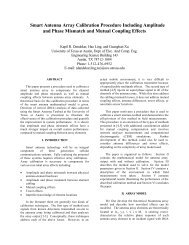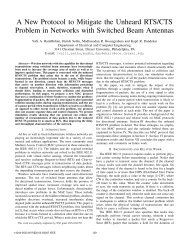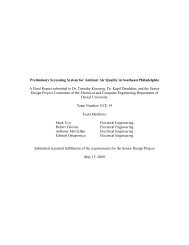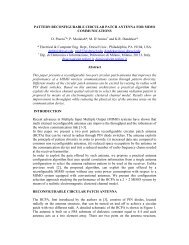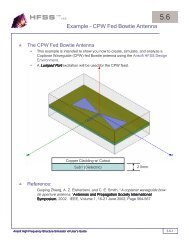Final Presentation - Drexel Wireless Systems Laboratory - Drexel ...
Final Presentation - Drexel Wireless Systems Laboratory - Drexel ...
Final Presentation - Drexel Wireless Systems Laboratory - Drexel ...
You also want an ePaper? Increase the reach of your titles
YUMPU automatically turns print PDFs into web optimized ePapers that Google loves.
ECE Team 01<br />
Justin Arling<br />
Kyle O'Connor<br />
Mike Mercieca<br />
Advisors<br />
Dr. Kapil Dandekar<br />
Dr. Timothy Kurzweg
Project Background<br />
-Hunting Park<br />
• The Hunting Park<br />
community is concerned<br />
with the amount of industrial<br />
activity in their area<br />
• They wanted to know how<br />
their air quality compares to<br />
the rest of the city and<br />
nation<br />
• A team was formed with the<br />
Clean Air Council, Chemical<br />
Heritage Foundation, and<br />
others to investigate<br />
2
Project Background<br />
• Philadelphia Air Management Service (AMS)<br />
o Monitors the air quality at various locations<br />
throughout Philadelphia and enforces city, state, and<br />
federal air quality standards<br />
o Weighing Filter Monitor<br />
• $100 - $200 per measurement<br />
• $25,000 - $50,000 to set up a weighing facility<br />
• Data takes 2 weeks to process<br />
o Continuous Filter Monitor (Met-One BAM-1020)<br />
• Cannot be used as final judge of air quality<br />
• $14,300 per device<br />
Ulva, M. et al, “Preliminary Screening System for Ambient Air Quality in Southeast Philadelphia – ECE-19,” <strong>Drexel</strong> University<br />
Electrical and Computer Engineering Senior Design, 2009<br />
4
Project Background<br />
• The Clean Air Council of Philadelphia (CAC) sponsored<br />
this project to design Air Quality Monitors with the following<br />
specifications:<br />
o Low cost (about $500 per node)<br />
o Low-profile<br />
o Easily Maintainable<br />
5
Last Year's Work<br />
• System for monitoring<br />
particulate matter has been<br />
developed<br />
o Low in Cost<br />
o Small in Size<br />
o Not easy to use<br />
• Technical Components<br />
o Dylos DC1100 Pro Laser<br />
Particle Counter<br />
o XBee <strong>Wireless</strong> Sensor<br />
Network<br />
o Base Station computer<br />
6
Key Improvements<br />
• Increased size of the network<br />
• Extended overall battery life for each node<br />
• Adjusted network configurations for easier<br />
deployments<br />
• Improved upon the usability of the system<br />
with the following features:<br />
o Intuitive deployment interface<br />
o Automated and continuous data processing<br />
o Real-time visualization of results via the<br />
internet<br />
• Continued validation of data accuracy<br />
7
System Components<br />
8
Work Completed<br />
-Node Construction<br />
9
Node Construction<br />
Node Hardware<br />
• Added a total of 7 new nodes to the system<br />
o Built 3 of the nodes ourselves<br />
o Mentored North Penn High School students in<br />
building the other 4 as part of the EPICS program<br />
10
Work Completed<br />
-Power<br />
11
Power<br />
• Battery life of the older system: ~6 Days<br />
• Parallel battery solution<br />
o Cost - $60 extra per node<br />
o Subject to current flowing from one battery<br />
to the other<br />
•Schottky Diode<br />
•Stops current from flowing from one to<br />
the other<br />
•Low Forward Voltage Drop<br />
12
Power<br />
-Battery Life Comparison<br />
Battery Type<br />
Impact Universal Li-<br />
Ion Rechargeable<br />
Battery (last year)<br />
Capacity Life for<br />
Single<br />
Battery<br />
(days)<br />
Life for<br />
Parallel<br />
Batteries<br />
(days)<br />
Improvement<br />
(%)<br />
8000 mAh 5.2 9.15 75.15<br />
Ultralast Universal<br />
Li-Ion Portable DVD<br />
Replacement Battery<br />
(this year)<br />
5400 mAh 3.41 6.41 88.06<br />
13
Work Completed<br />
-Networking<br />
14
Networking<br />
• Previous issues:<br />
o System range was limited to approximately<br />
150 meters when line-of-sight<br />
o Can take several cycles for a new node to<br />
synchronize with the network's sleep<br />
schedule<br />
• Improvements:<br />
o Implementation of firmware upgrade allows<br />
network hopping and faster sync times<br />
15
Network Hopping<br />
16
Network Hopping<br />
17
Network Hopping<br />
18
Network Hopping<br />
19
Network Hopping<br />
20
Network Hopping<br />
21
Network Hopping<br />
22
Network Hopping<br />
23
Network Hopping<br />
24
Networking<br />
• Previous firmware required all nodes,<br />
including the base station, to sleep<br />
• New firmware allows base station to<br />
remain awake at all times<br />
o Typical sync time is only a few seconds<br />
•Node is turned on and broadcasts signal<br />
•Base station 'sees' node and sends<br />
sleep schedule<br />
•Node begins following schedule<br />
25
Data Collection<br />
&<br />
Visualization<br />
Demonstration<br />
Backup Slides<br />
26
Data Validation<br />
• Humidity Correction Factor<br />
o F = O x H x C<br />
• F - <strong>Final</strong> Concentration<br />
• O - Output Concentration<br />
• H - Relative Humidity<br />
• C - Correction Factor<br />
• Data was collected in a side-byside<br />
deployment with AMS<br />
monitors for 33 days<br />
o 3,177 usable data points<br />
Lee, J. et al., “Seasonal variations of particle size distributions of PAHs at Seoul, South Korea,” Air Quality Atmospheric Health,<br />
vol. 1, pp. 57-68, 2008.<br />
Tittarelli, T. et al., “Estimation of particle mass concentration in ambient air using a particle counter,” Atmospheric Environment, vol.<br />
42, pp. 8543-8548, 2008.<br />
27
Data Validation<br />
• Correction factors used last year have been updated in<br />
order to account for the new data<br />
Before Correction:<br />
Average concentration<br />
measured 4.98 μg/m 3 (95%<br />
CI 4.71 to 5.24) lower than<br />
measured by Air<br />
Management Services<br />
After Correction:<br />
Average concentration<br />
measured 0.63 μg/m 3 (95%<br />
CI 0.4 to 0.87) lower than<br />
measured by Air<br />
Management Services<br />
28
Data Validation<br />
*Supplemental documentation has been created for a more<br />
detailed discussion on the efforts and results associated with<br />
data validation.<br />
29
Differences from Last Year<br />
Previous Design<br />
New Design<br />
Number of Nodes 5 12<br />
Power (Battery Life) 6 Days >9 Days<br />
Power Consumption Single Battery Dual-Batteries<br />
Network Technology XBee Improved XBee<br />
Network Range<br />
~150 Meters<br />
Up to ~300 Meters<br />
(single hop)<br />
Data Processing<br />
Data Viewing<br />
Manual Process<br />
Excel Output<br />
at Base Station<br />
Automatic &<br />
Continuous<br />
-Mapped Results<br />
-Streaming Data<br />
-Web Based View<br />
30
Engineering Projects in<br />
Community Service (EPICS)<br />
• Worked with students from North Penn High<br />
*Financially supported through IEEE New Initiatives, EPICS in High Schools<br />
31
EPICS<br />
• Worked together to build<br />
an additional four nodes<br />
• Constructed PCBs for the<br />
power circuitry<br />
• Developed a plan to<br />
monitor air quality in<br />
school bus loading zones<br />
32
Timeline<br />
• All deadlines for deliverables were met as scheduled<br />
• <strong>Final</strong> term milestones were as follows:<br />
o Completed software and data visualization<br />
o Improved data correction factors based on AMS<br />
Deployment<br />
o Deployments in Norris Square and Hunting Park<br />
33
Project Deliverables<br />
34
Budget<br />
Over Budget by roughly $130 - 3.56%<br />
35
Future Work<br />
• Continued data validation to capture yearround<br />
environmental scenarios<br />
• Implementation of a low-cost GPS solution<br />
• Improving air flow to particle counter<br />
• Adding a localized humidity sensor<br />
• Monitoring the battery power remotely<br />
36
Questions<br />
Justin Arling<br />
Kyle O'Connor<br />
Michael Mercieca<br />
- ja98@drexel.edu<br />
- ko43@drexel.edu<br />
- mm533@drexel.edu<br />
We would like to acknowledge the following groups<br />
for their time, effort, and support.<br />
Philadelphia Clean Air Council<br />
Air Management Services<br />
Chemical Heritage Foundation<br />
Hunting Park Stakeholders Group<br />
37
Backup Slides<br />
38
Humidity Correction Factor<br />
39
Data Validation Numbers<br />
40
Power<br />
• 2 Schottky Diodes in Parallel<br />
o Voltage drop of only 0.27 V<br />
o Dissipates heat buildup<br />
41
Constraints<br />
• Economic<br />
o Cost Effective<br />
• $500 per node<br />
o Parts must be cost effective<br />
• Low cost batteries<br />
• Pay as you go Broadband service<br />
• Upgrades were hand created voltage regulator<br />
o Quality did not suffer as a result<br />
• Manufacturability<br />
o Enclosures low-profile and weatherproof<br />
o Relative simplicity of the system<br />
• Allows for future build outs to be successful<br />
42
Constraints<br />
• Sustainability<br />
o Designed for a long lifespan<br />
• Parts are interchangeable<br />
o Increased lifespan of power<br />
• Putting 2 batteries in parallel does this<br />
• Schottkey diodes dissipate heat and reduce wear on<br />
system<br />
• Environmental<br />
o When deploying the systems, buildings, trees, and<br />
weather limit the range<br />
o Nodes need to be hung with vents facing downward<br />
• Ethical Health and Safety<br />
o Goal to improve the public's overall environment<br />
o Project driven by this, not constrained<br />
o Clean Air Council must carefully consider what to do with<br />
the information this project gives<br />
43
Constraints<br />
• Social<br />
o Public has to be supportive and helpful<br />
• This allows for a much larger deployment area<br />
o Without public help, system would be placed in unsafe<br />
area that could lead to theft and tampering<br />
• Political<br />
o Working with and within the Clean Air Council and AMS's<br />
boundaries is a must<br />
o The Clean Air Council's requirements were a driving force<br />
to the project<br />
o Approval from AMS to hang a node at their facility was<br />
required to continue with data validation<br />
o When deploying the system, it needed to be explicitly<br />
stated that the system was a preliminary screening and<br />
not the final authority on the air quality in the area<br />
44
Industrial Budget<br />
45
<strong>Drexel</strong> Monitor vs Industrial Monitors<br />
AMS Weighing Filter System<br />
Met-One BAM-1020<br />
Ulva, M. et al, “Preliminary Screening System for Ambient Air Quality<br />
in Southeast Philadelphia – ECE-19,” <strong>Drexel</strong> University Electrical and<br />
Computer Engineering Senior Design, 2009<br />
46
Fall - Proposed<br />
47
Fall - Actual<br />
48
Winter -<br />
Proposed<br />
49
Winter -<br />
Actual<br />
50
Spring -<br />
Proposed<br />
51
Spring -<br />
Actual<br />
52
Data Validation<br />
65


